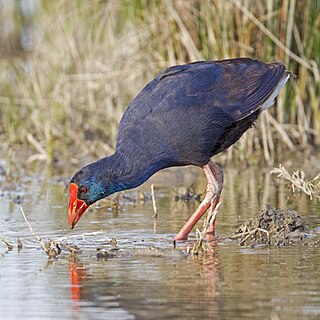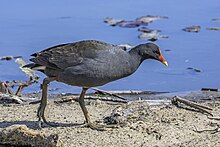
Rails are a large, cosmopolitan family of small- to medium-sized terrestrial and/or semi-amphibious birds. The family exhibits considerable diversity in its forms, and includes such ubiquitous species as the crakes, coots, and gallinule; other rail species are extremely rare or endangered. Many are associated with wetland habitats, some being semi-aquatic like waterfowl, but many more are wading birds or shorebirds. The ideal rail habitats are marsh areas, including rice paddies, and flooded fields or open forest. They are especially fond of dense vegetation for nesting. The rail family is found in every terrestrial habitat with the exception of dry desert, polar or freezing regions, and alpine areas. Members of Rallidae occur on every continent except Antarctica. Numerous unique island species are known.

The common moorhen, also known as the waterhen or swamp chicken, is a bird species in the rail family (Rallidae). It is distributed across many parts of the Old World, from Africa to Europe and Asia.

The common gallinule is a bird in the family Rallidae. It was split from the common moorhen by the American Ornithologists' Union in July 2011. It lives around well-vegetated marshes, ponds, canals, and other wetlands in the Americas. The common gallinule is one of the most conspicuous rail species in North America, along with the American coot.

The Eurasian coot, also known as the common coot, or Australian coot, is a member of the rail and crake bird family, the Rallidae. It is found in Europe, Asia, Australia, New Zealand and parts of North Africa. It has a slaty-black body, a glossy black head and a white bill with a white frontal shield. The sexes are similar. Similar looking coot species are found throughout the world, with the largest variety of coot species living in South America.

The western swamphen is a species of swamphen in the rail family Rallidae, one of the six species of purple swamphen. From the French name talève sultane, it is also known as the sultana bird. This chicken-sized bird, with its large feet, bright plumage and red bill and frontal shield is easily recognisable in its native range. It used to be considered the nominate subspecies of the purple swamphen, but is now recognised as a separate species. The western swamphen is found in wetlands in Spain, Portugal, southeastern France, Italy and northwestern Africa.

The purple gallinule is a swamphen in the genus Porphyrio. It is in the order Gruiformes, meaning "crane-like", an order which also contains cranes, rails, and crakes. The purple gallinule is a rail species, placing it into the family Rallidae. It is also known locally as the yellow-legged gallinule. The specific name martinica denotes "of Martinique".

Moorhens—sometimes called marsh hens—are medium-sized water birds that are members of the rail family (Rallidae). Most species are placed in the genus Gallinula, Latin for "little hen." They are close relatives of coots. They are often referred to as (black) gallinules. Recently, one of the species of Gallinula was found to have enough differences to form a new genus Paragallinula with the only species being the lesser moorhen.

The watercock is a waterbird in the rail and crake family, Rallidae that is widely distributed across Southeast Asia. It is the only member of the genus Gallicrex.

Porphyrio is the swamphen or swamp hen bird genus in the rail family. It includes some smaller species of gallinules which are sometimes separated as genus Porphyrula or united with the gallinules proper in Gallinula. The Porphyrio gallinules are distributed in the warmer regions of the world. The group probably originated in Africa in the Middle Miocene, before spreading across the world in waves from the Late Miocene to Pleistocene.

The Gough moorhen is a medium-sized, almost flightless bird that is similar to the common moorhen, but is smaller, stockier, and has shorter wings. The bird has a distinctive yellow-tipped red bill and red frontal shield. Its first account was written in 1888 by the polar explorer George Comer, whom the specific name comeri commemorates. This bird is found only on two remote islands in the South Atlantic.

The black crake is a waterbird in the rail and crake family, Rallidae. It breeds in most of sub-Saharan Africa except in very arid areas. It undertakes some seasonal movements in those parts of its range which are subject to drought. No subspecies have been described. It appears that the oldest available name for this species is actually Rallus niger J. F. Gmelin, 1788, but Swainson believed that the earlier name was unidentifiable, and his own has since become well embedded in the literature.

The pale-vented bush-hen is a medium sized waterbird, mainly blue-grey with a buff vent and undertail. It is found in Australia, the Moluccan Islands, New Guinea, the Bismarck Archipelago and the Solomon Islands. Its natural habitat is subtropical or tropical moist lowland forests.

The white-winged coot is a species of bird in subfamily Rallinae of family Rallidae, the rails, gallinules, and coots. It is found in Argentina, Bolivia, Brazil, Chile, Paraguay, Uruguay, and the Falkland Islands.

The azure gallinule is a species of bird in subfamily Rallinae of family Rallidae, the rails, gallinules, and coots. It is found in Argentina, Bolivia, Brazil, Colombia, Ecuador, French Guiana, Guyana, Paraguay, Peru, Suriname, Trinidad and Tobago, and Venezuela.

The Australian crake , also known as Australian spotted crake, or spotted crake is a species of bird in the family Rallidae. It is the only species of Australian crake in the genus Porzana.

The Australasian swamphen is a species of swamphen (Porphyrio) occurring in eastern Indonesia, Papua New Guinea, Australia and New Zealand. In New Zealand, it is known as the pūkeko. The species used to be considered a subspecies of the purple swamphen.

Marievale Bird Sanctuary is a protected area in Gauteng, South Africa. It is about 15 km2 in size, and situated on the East Rand on the southern half of the Blesbokspruit wetland, a Ramsar site. The Blesbokspruit is a major perennial river in Gauteng which is flanked by extensive floodplains on either side. Nearby is the Suikerbosrand Nature Reserve.

Lake Lorne, a small 12-hectare (30-acre) freshwater lake on the Bellarine Peninsula, Victoria, Australia, is located immediately south-west of the township of Drysdale.

The Hawaiian gallinule is an endangered chicken-sized water bird in the rail family. It is also variously known as the Hawaiian common gallinule, Hawaiian moorhen, Hawaiian common moorhen, mudhen, or ‘alae ‘ula in Hawaiian, and sometimes misleadingly as the Hawaiian red coot. It is a subspecies of the common gallinule that is endemic to the tropical Hawaiian Islands of the north-central Pacific Ocean.

A frontal shield, also known as a facial shield or frontal plate, is a feature of the anatomy of several bird species. Located just above the upper mandible, and protruding along the forehead, it is composed of two main parts: a hard, proteinaceous callus and a soft, fleshy corium. It is thought to play roles in protection, mate identification, sexual selection, and territorial defense.



























